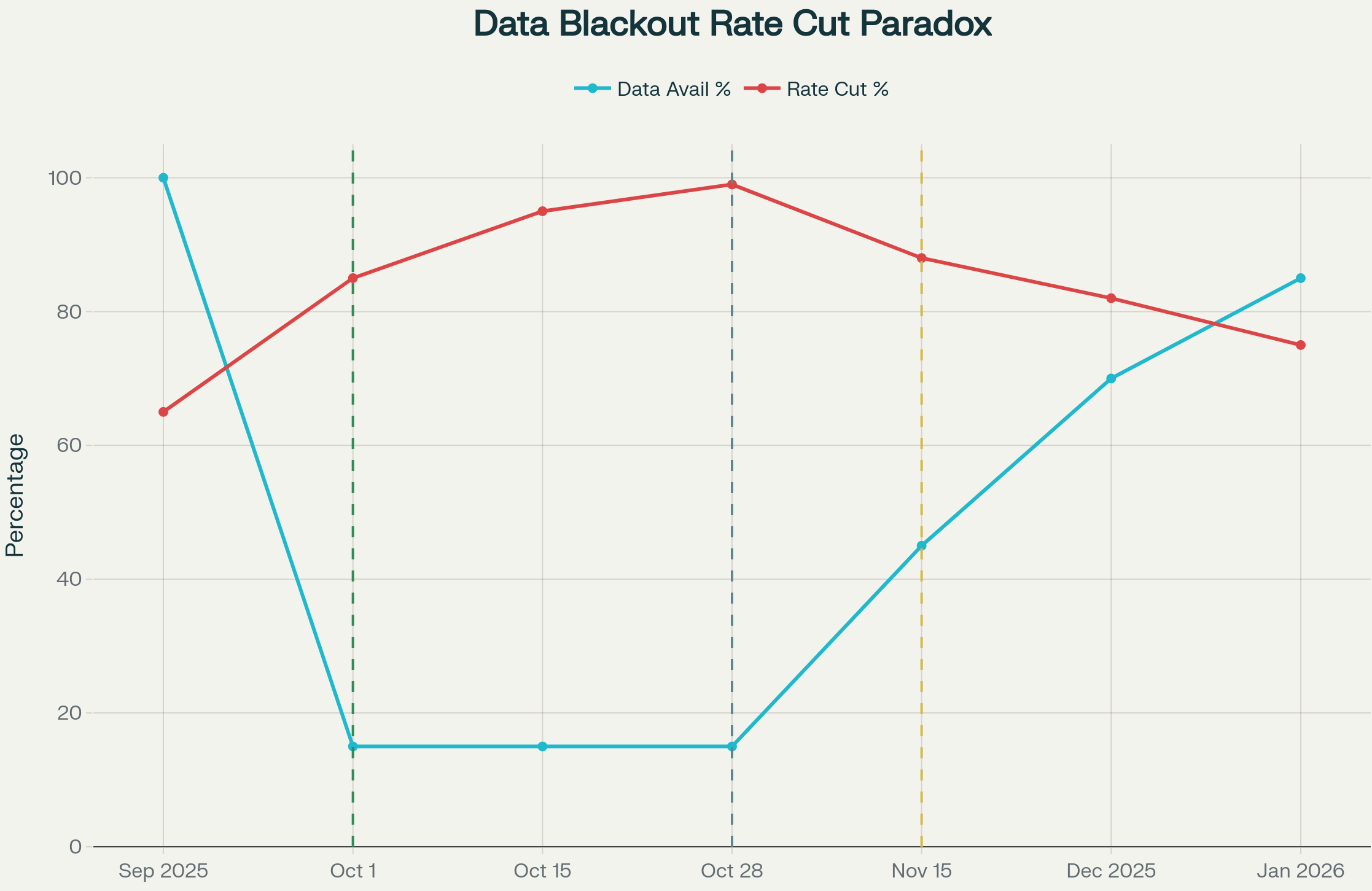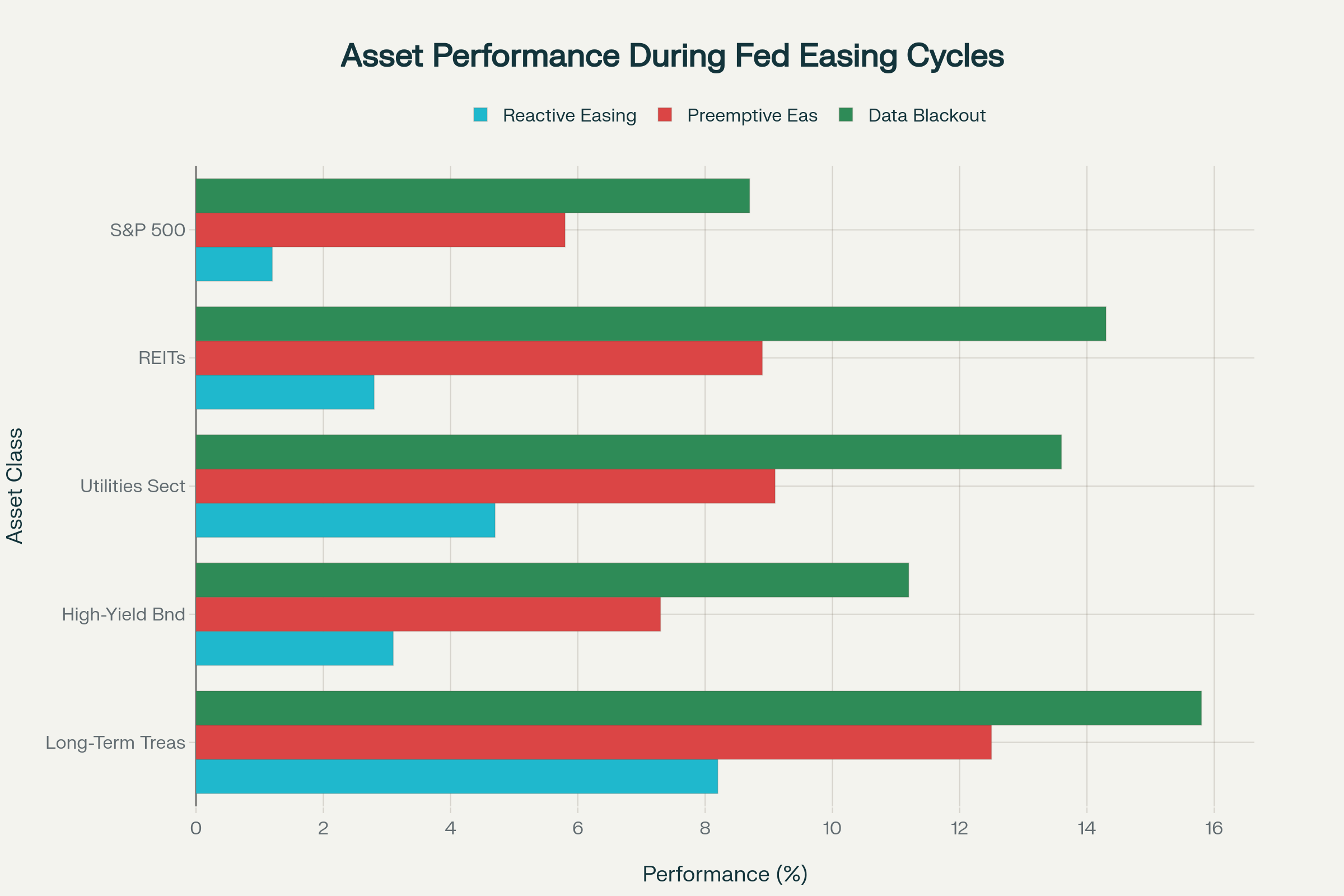e.l.f. Beauty stock plummets 20% as revenue and guidance fall short of expectations
The government shutdown means the Fed is missing key economic data. This unusual situation could push the Fed to cut rates early, before official reports show any real weakness. As a result, markets might rally before the bad news appears in the data.
The October 1st government shutdown did more than furlough workers and delay services. It severed the Federal Reserve’s primary lifeline to the US economy. With critical releases from the Bureau of Labor Statistics, Census Bureau, and Bureau of Economic Analysis now delayed or halted, policymakers face a rare challenge: making interest rate decisions while flying blind through an economic landscape that may already be deteriorating.
Market participants have taken notice. Interest rate futures now show 99% probability of a quarter-point cut at the October 28-29 FOMC meeting, with 88% odds of another reduction in December. These expectations have strengthened since the shutdown began, suggesting investors view the data vacuum not as a problem, but as a catalyst for aggressive Fed accommodation.
The Information Paradox: When Ignorance Becomes Policy
The Federal Reserve has built its credibility on data-dependent decision-making. Yet the shutdown flips this framework on its head. Without access to employment reports, inflation data, and GDP statistics, the central bank loses its informational advantage. The result? Rate cuts become easier to justify, not harder.
The mechanism works like this. Under normal conditions, when the Fed cuts rates, markets interpret the move as signaling economic weakness (the "Fed Information Effect"). But when policymakers themselves lack comprehensive data, this signaling breaks down. Rate cuts become purely precautionary "risk management" moves rather than confirmations of economic distress.
Fed Chair Jerome Powell already characterized September’s rate reduction as a "risk management cut," suggesting the central bank would rather ease preemptively than risk falling behind the curve. Bank of America economists note that "a strong jobs report for September would be necessary to maintain the option of holding rates steady in October. In the absence of this data, Chair Powell is likely to advocate another management cut."
The data blackout takes this logic further. Without definitive evidence either way, the Fed faces asymmetric political and economic risks. Criticism for under-easing would likely prove more severe than criticism for over-accommodation, particularly with the Trump administration pressuring for lower rates.
The counterintuitive relationship between Fed data availability and market expectations for rate cuts during the 2025 government shutdown, with less information driving more aggressive monetary policy expectations.
Historical Precedent: Uncertainty Breeds Accommodation
Past Federal Reserve easing cycles reveal a clear pattern: data uncertainty accelerates monetary loosening rather than constraining it. During the 1998 Long-Term Capital Management crisis, the Fed implemented three rapid cuts within weeks despite limited real-time economic data about the broader impact. Similarly, early pandemic response saw rates slashed to zero based on preliminary indicators rather than comprehensive statistical confirmation.
This "insurance cut" framework prioritizes preventing negative outcomes over waiting for definitive data. Goldman Sachs analysis indicates standard errors in economic data are currently 26% higher than pre-pandemic levels, creating additional cover for preemptive action even when statistics eventually resume.
The current environment amplifies these tendencies. FOMC members facing substantial uncertainty are likely to converge toward the politically and economically safer choice of accommodation. The alternative carries real risk: maintaining current rates while economic conditions potentially deteriorate undetected would damage both the Fed’s reputation and its policy effectiveness.
Market Mechanics: The Liquidity Premium Before the Pain
Financial markets are already pricing in this dynamic, creating a disconnect between policy expectations and economic reality. When the Fed cuts rates preemptively rather than reactively, markets typically experience a "liquidity premium effect." Lower discount rates boost asset valuations, improve credit conditions, and increase risk appetite, all without the economic pessimism that accompanies data-confirmed weakness.
This explains the current market anomaly. Major U.S. equity indices are approaching record territory even as private sector hiring metrics and small-business sentiment show meaningful cooling. The S&P 500 has gained 3.2% since mid-September, while private payroll services report the weakest hiring pace since early 2024.
Capital markets respond to forward-looking policy calculus, not current employment figures. Wall Street celebrates anticipated liquidity while Main Street feels genuine economic pressure. That gap creates both opportunity and risk for investors.
Strategic Implications Across Asset Classes
The data blackout scenario creates specific opportunities for tactical positioning:
Duration plays: Long-term Treasury bonds become particularly attractive as preemptive Fed easing flattens the yield curve and reduces terminal rate expectations. The 10-year yield has already declined 18 basis points since shutdown fears intensified in late September.
Credit spread compression: Corporate bonds, especially high-yield instruments, benefit disproportionately from Fed accommodation that occurs before actual credit stress emerges. Improved liquidity conditions prevent spread widening rather than merely responding to it.
Equity sector rotation: Interest-sensitive sectors, including utilities and real estate investment trusts, typically outperform during easing cycles. The current environment offers the added benefit of monetary stimulus without accompanying economic pessimism.
Cross-asset plays: Currency and international asset markets may offer openings as the Fed eases with limited visibility, while other major central banks operating with full data sets remain more constrained in their policy responses.
Risk Factors and Reality Checks
The contrarian thesis for aggressive Fed easing faces several legitimate challenges. A rapid shutdown resolution could restore data flow and remove justification for preemptive cuts. If private sector indicators or anecdotal evidence suggest renewed inflationary pressure, the Fed might pause despite data uncertainty.
Current market positioning is also quite extreme, leaving little room for positive surprises and significant downside risk if the Fed proves less dovish than futures markets anticipate. Moreover, preemptive cuts that lack follow-through on actual economic improvement could damage Fed credibility and encourage the exact asset-price-versus-fundamentals imbalance that contributed to past financial instability.
When comprehensive government data eventually resumes, likely with significant backlogs and revision complications, markets may face a reckoning if the delayed statistics confirm deeper weakness than anticipated.
Projected asset class returns during different Federal Reserve easing scenarios, highlighting the superior performance potential during data blackout periods
The Bottom Line for Investors
The government shutdown has created an unusual environment where uncertainty itself becomes monetary policy fuel. The Federal Reserve’s data-dependent framework, when deprived of reliable data, tilts toward accommodation as policymakers seek to prevent undetected deterioration.
For investors, this creates a window to capture liquidity-driven gains before economic reality shows up in delayed statistics. The opportunity is inherently time-limited. Position for near-term policy-driven upside while maintaining discipline and flexibility to adapt when data visibility returns.
Key Levels to Monitor
Fed funds futures for any shift in October/December cut expectations; the S&P 500’s 200-day moving average at 6,845 as critical technical support; and the 10-year Treasury yield at 4.25%, below which duration trades gain momentum. Critical catalysts include any shutdown resolution timeline and the eventual release of backlogged employment and inflation data. Those releases will provide the first real test of whether aggressive Fed positioning was justified or premature.
